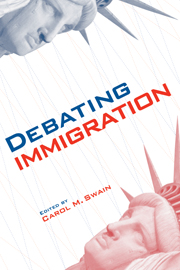Book contents
- Frontmatter
- Contents
- About the Contributors
- Preface
- Acknowledgments
- 1 Introduction
- PART I PHILOSOPHY AND RELIGION
- PART II LAW AND POLICY
- PART III ECONOMICS AND DEMOGRAPHICS
- PART IV RACE
- 13 The Congressional Black Caucus and the Impact of Immigration on African American Unemployment
- 14 Hispanic and Asian Immigrants
- 15 Strange Bedfellows, Unintended Consequences, and the Curious Contours of the Immigration Debate
- PART V COSMOPOLITANISM
- PART VI CONCLUSION
- Notes
- Index
15 - Strange Bedfellows, Unintended Consequences, and the Curious Contours of the Immigration Debate
Published online by Cambridge University Press: 05 June 2012
- Frontmatter
- Contents
- About the Contributors
- Preface
- Acknowledgments
- 1 Introduction
- PART I PHILOSOPHY AND RELIGION
- PART II LAW AND POLICY
- PART III ECONOMICS AND DEMOGRAPHICS
- PART IV RACE
- 13 The Congressional Black Caucus and the Impact of Immigration on African American Unemployment
- 14 Hispanic and Asian Immigrants
- 15 Strange Bedfellows, Unintended Consequences, and the Curious Contours of the Immigration Debate
- PART V COSMOPOLITANISM
- PART VI CONCLUSION
- Notes
- Index
Summary
I am a reporter with Newhouse News Service. Since 1991, I have been writing stories exclusively about race and immigration. Those stories are then sent to two dozen newspapers across the country owned by the Newhouse family and to an assortment of other subscribing papers, all of which can use the stories as they see fit.
Early in my tenure, prompted by developments in California, I became interested in the question of whether there was a new form of white flight afoot, this time away from the growing diversity in those places receiving the most immigrants. To help find the answer, I entered into what would become a long and continuing collaboration with the demographer William Frey of the Population Studies Center at the University of Michigan. The first fruit of our collaboration was a story that appeared in the summer of 1993. It began as follows: “Unprecedented white flight from the breaking waves of immigration is transforming the American landscape in sweeping ways.”
The story reported that while most immigrants in the 1980s were settling in a handful of states, significant numbers of whites in those states were relocating to places then largely untouched by immigration. It was, as the story put it, “recreating on a grand scale the classic pattern of white suburbs ringing minority cities.”
In the body of the story I noted that blacks, too, were leaving prime immigrant destinations and relocating to thriving black communities, mostly back south, Atlanta foremost among them.
- Type
- Chapter
- Information
- Debating Immigration , pp. 206 - 220Publisher: Cambridge University PressPrint publication year: 2007

